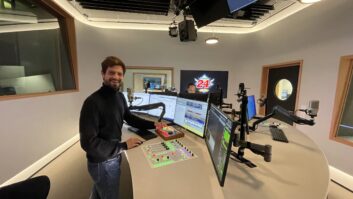TORONTO— Since 2009 Bell Media Radio has been using Lawo consoles and routers in its Toronto radio operations. The main Toronto system is based on zirkon consoles for the stations’ master control rooms and crystal consoles used for edit and production rooms. The backbone of the system is a Lawo Nova 73 router, backed up by a smaller Nova 17 router. There are two zirkon and 14 crystal consoles connected via fiber MADI to the Nova 73 and Nova 17 routers.
Our reasons for choosing Lawo for our radio operations include its robust architecture and the ability to scale. Lawo also is the primary choice for many of Bell Media’s TV production consoles, which means that engineering staff can draw on technical expertise from elsewhere in the company.
LAYERS

This year, we have expanded our Toronto radio operations to include TSN Radio 1050, an all-sports station. The decision was made to collocate TSN Radio with the TSN TV operations at Bell Media’s Agincourt campus in the northeast end of Toronto.
The plans called for a main on-air control room, a news booth and three edit stations. Once again, we decided to utilize Lawo systems. In addition to the familiar crystal consoles for the news and edit/production areas, we used two new products from Lawo — the sapphire console in the control room and the Nova 29 router as the backbone.
The TSN Radio system was designed to support TV simulcasts, which requires that the console and router be able to scale in order to handle the additional sources required for integration with TV production. These include video router feeds and outputs from various video clip servers.
The sapphire was an ideal audio console for this purpose with its dual-layer functionality, which effectively doubled the number of fader sources that can be assigned to the console, while also providing a logical grouping between frequently accessed and occasionally accessed input sources.
In our case the most frequently accessed radio sources are found on the A Layer, while the TV only inputs were placed on the less frequently accessed B Layer. Note that both A and B sources can be active simultaneously. We utilized a 28-fader control surface for this project because, in addition to the TV sources, it is necessary to manage a large number of satellite and codec sources for our broadcasts. The Lawo sapphire systems, along with the backend router, handle all our mix-minus requirements.
The core of the router is the other new Lawo product, the Nova 29 MADI router supporting up to 16 bidirectional 64-channel MADI connections, which provides an overall routing matrix capable of 1,024 inputs x 1,024 outputs. Two Nova 29 routers in a redundant configuration provide the core router to the TSN Radio system. All the consoles have dual fiber connections back to the redundant Nova 29 core. In addition, a Nova 17 frame provides the additional AES and analog I/O in our equipment racks for centrally located codecs and the RCS master control automation systems.
Bell Media has found Lawo consoles and routers to be flexible and very reliable. The versatility continues to improve as we now have ability to add Ravenna audio-over-IP cards to the existing system.
For information, contact Herbert Lemcke at Lawo in Ontario at (416) 292-0078 or visit www.lawo.ca.
Radio World User Reports are unpaid testimonials; they are intended to allow equipment users to explain why they chose a particular product. Radio World Product Evaluations, by comparison, are paid articles written by a contributing reviewer, usually an engineer.












